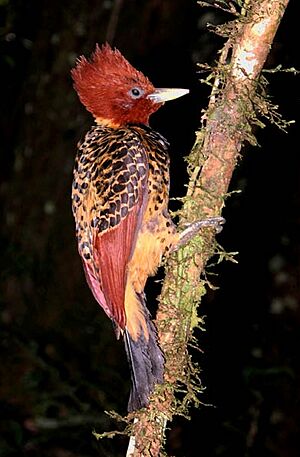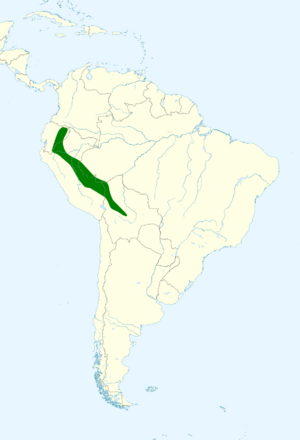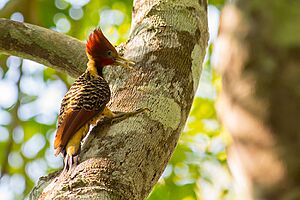Rufous-headed woodpecker facts for kids
Quick facts for kids Rufous-headed woodpecker |
|
|---|---|
 |
|
| Conservation status | |
| Scientific classification | |
| Genus: |
Celeus
|
| Species: |
spectabilis
|
 |
|
The rufous-headed woodpecker (Celeus spectabilis) is a type of bird that belongs to the woodpecker family. You can find this bird in countries like Bolivia, Brazil, Ecuador, and Peru.
Contents
About the Rufous-Headed Woodpecker
Different Types of This Woodpecker
The rufous-headed woodpecker has two main types, called subspecies. These are C. s. spectabilis and C. s. exsul. Long ago, another woodpecker, Kaempfer's woodpecker, was thought to be a third type of this bird. But scientists later decided it was a separate species.
What Does This Woodpecker Look Like?
This woodpecker is about 26 to 28 centimeters (10 to 11 inches) long. One type, C. s. exsul, weighs about 111 grams (3.9 ounces).
Male and female woodpeckers look very similar, but there's a small difference on their heads. Males have bright red patches on their cheeks and a bigger red patch on their bushy crest. Females do not have the red cheek patch and only a tiny bit of red on their crest.
Both male and female woodpeckers have a reddish-brown head. They have a creamy patch on their neck that goes down to their chest. Their lower throat and chest are black. The back of their neck and upper back are creamy or pale yellow with wide black stripes. Their lower back and rump are yellow-brown.
Their wings are black with creamy edges and thin stripes. The main flight feathers are brownish-black, and other wing feathers are reddish-brown with black tips. Their tail is black, sometimes with light stripes on the outer feathers.
The woodpecker's bill is pale yellowish or grayish. Its eyes are deep red-brown, and its legs are olive green or grayish. Young woodpeckers look like adults but have a darker bill and more black on the front of their head. They also have more red on their crown.
Where Do Rufous-Headed Woodpeckers Live?
The C. s. spectabilis subspecies lives in eastern Ecuador and northeastern Peru. The C. s. exsul subspecies is found in southeastern Peru, Brazil's Acre state, and northern Bolivia.
These woodpeckers live in wet tropical rainforests. They often prefer areas along rivers and on islands in those rivers. In Peru and Brazil, they are often found near Chusquea and Guadua bamboo plants. In Ecuador, they like areas with Cecropia trees and Gynerium cane plants. They usually live at low elevations, up to about 300 meters (980 feet) high.
How Do Rufous-Headed Woodpeckers Behave?
Movement and Home
The rufous-headed woodpecker stays in the same area all year round. It does not migrate.
What Do They Eat?
Scientists believe these woodpeckers mostly eat ants that live in bamboo. They probably eat other insects too. They usually look for food alone or in pairs. They search for food at all levels of the forest, even on fallen logs. They use their strong bills to poke and peck at tree trunks, branches, and bamboo to find their prey.
Reproduction and Life Cycle
The breeding season for the rufous-headed woodpecker in Peru is from at least June to August. We don't know much about their breeding in other places. Only two nests have ever been found and described. One nest was about 3 meters (10 feet) high in a dead tree. The other was about 2 meters (7 feet) high in a living Cavanillesia tree. The first nest was destroyed before the eggs hatched. The second nest had one chick, and a male woodpecker was bringing it food. We still have a lot to learn about how these woodpeckers raise their young.
Sounds and Calls
The rufous-headed woodpecker has a loud, squealing song that sounds like "skweeah." This is often followed by a bubbling sound like "kluh-kluh-kluh-kluh-kluh." It also makes a soft, purring chuckle. When it's upset, it makes harsh squawks. It also drums on trees, making loud, steady rolls, especially when it finds hollow bamboo.
Conservation Status
The IUCN (International Union for Conservation of Nature) says the rufous-headed woodpecker is a species of "Least Concern." This means it is not currently in danger of disappearing. It lives in a fairly large area, but we don't know exactly how many of these birds there are. We also don't know if their numbers are going up or down.
There are no immediate threats to this woodpecker. It is generally rare, but it is not uncommon in its small area in Brazil. Because it needs a very specific type of home and there aren't many of them, some people think it might need more protection in the future.



